Organizational Behaviour: Google's Culture and Practices Report
VerifiedAdded on 2020/11/23
|12
|3086
|258
Report
AI Summary
This report delves into the organizational behavior of Google, examining its culture, communication strategies, and employee motivation techniques. The study employs both primary and secondary research methods. Primary research involves interviews with Google employees to understand their expectations, the working environment, decision-making processes, and leadership styles. The findings highlight Google's emphasis on employee satisfaction, flexible working hours, a safe and fun environment, and collective decision-making. Secondary research explores theories of organizational culture, communication, and motivation, including Handy's model of organizational culture, formal and informal communication, and Herzberg's two-factor theory. The report identifies Google's culture as a blend of task and role cultures, emphasizing teamwork, well-defined roles, and responsibilities. The analysis concludes that Google's culture fosters effective internal communication and motivates employees through various benefits and opportunities, contributing to the company's success. The report emphasizes the importance of positive attitudes, flexible communication, and employee recognition in Google's organizational culture. The report is contributed by a student to be published on the website Desklib, which provides all the necessary AI-based study tools for students.
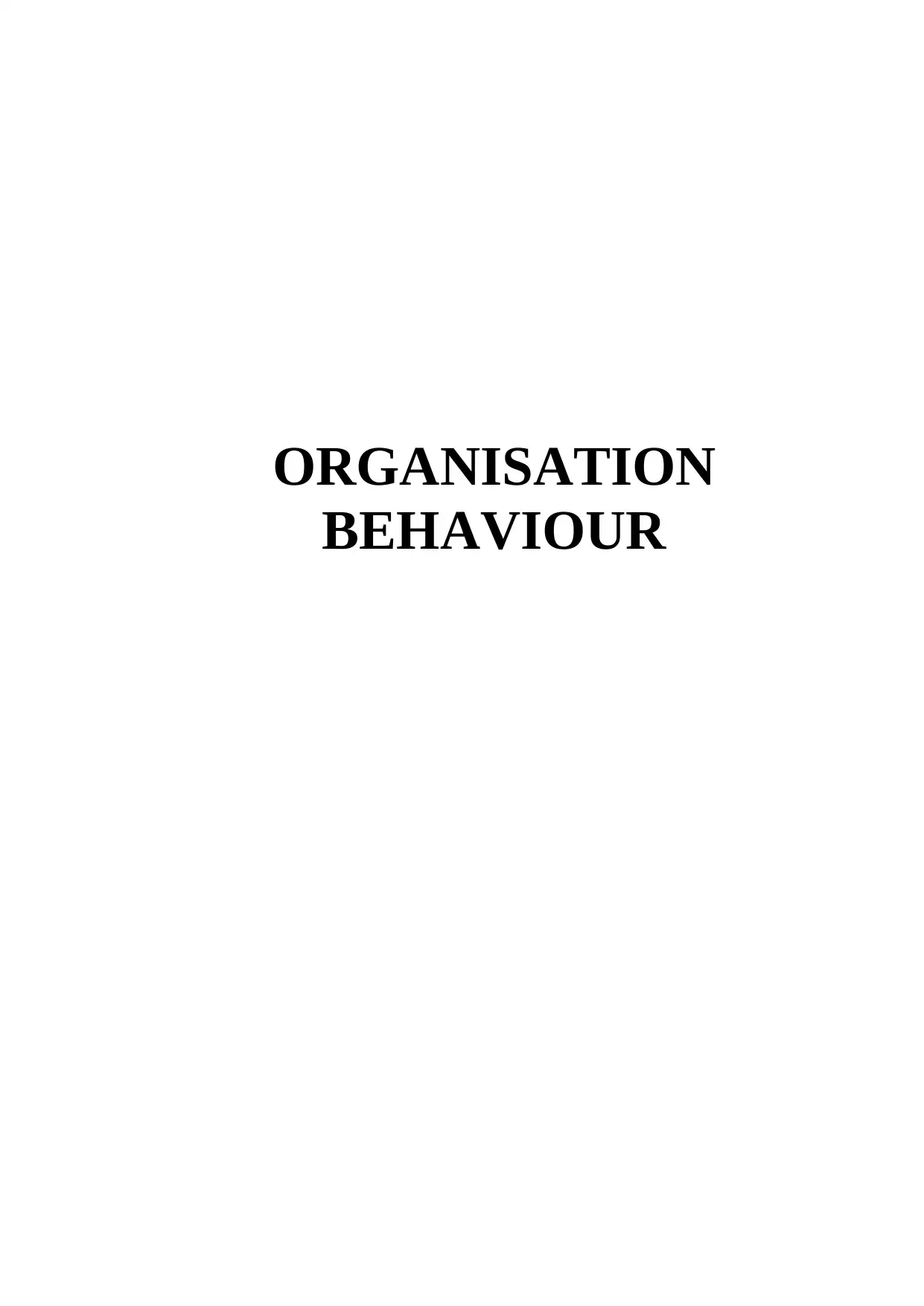
ORGANISATION
BEHAVIOUR
BEHAVIOUR
Paraphrase This Document
Need a fresh take? Get an instant paraphrase of this document with our AI Paraphraser
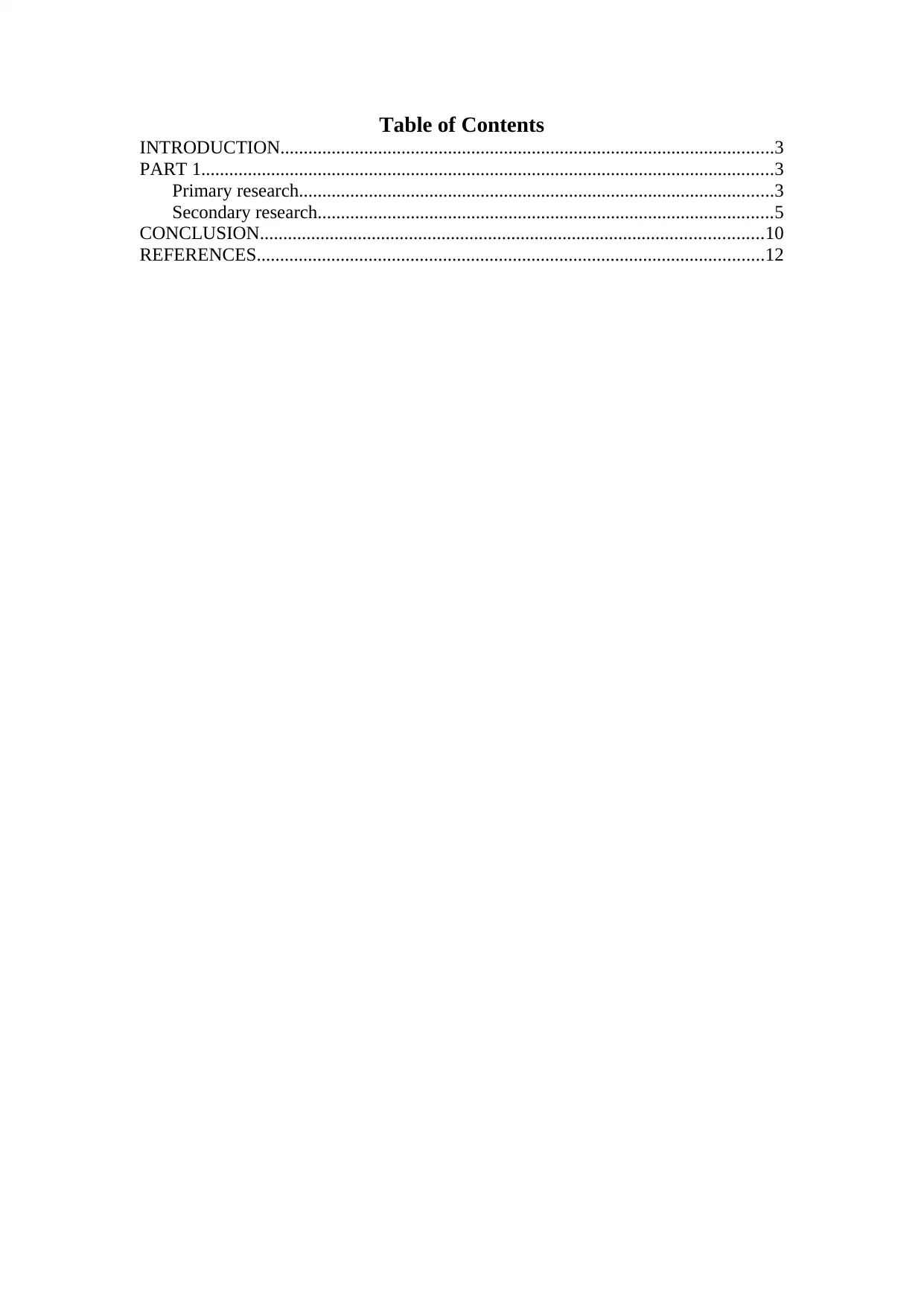
Table of Contents
INTRODUCTION..........................................................................................................3
PART 1...........................................................................................................................3
Primary research......................................................................................................3
Secondary research..................................................................................................5
CONCLUSION............................................................................................................10
REFERENCES.............................................................................................................12
INTRODUCTION..........................................................................................................3
PART 1...........................................................................................................................3
Primary research......................................................................................................3
Secondary research..................................................................................................5
CONCLUSION............................................................................................................10
REFERENCES.............................................................................................................12
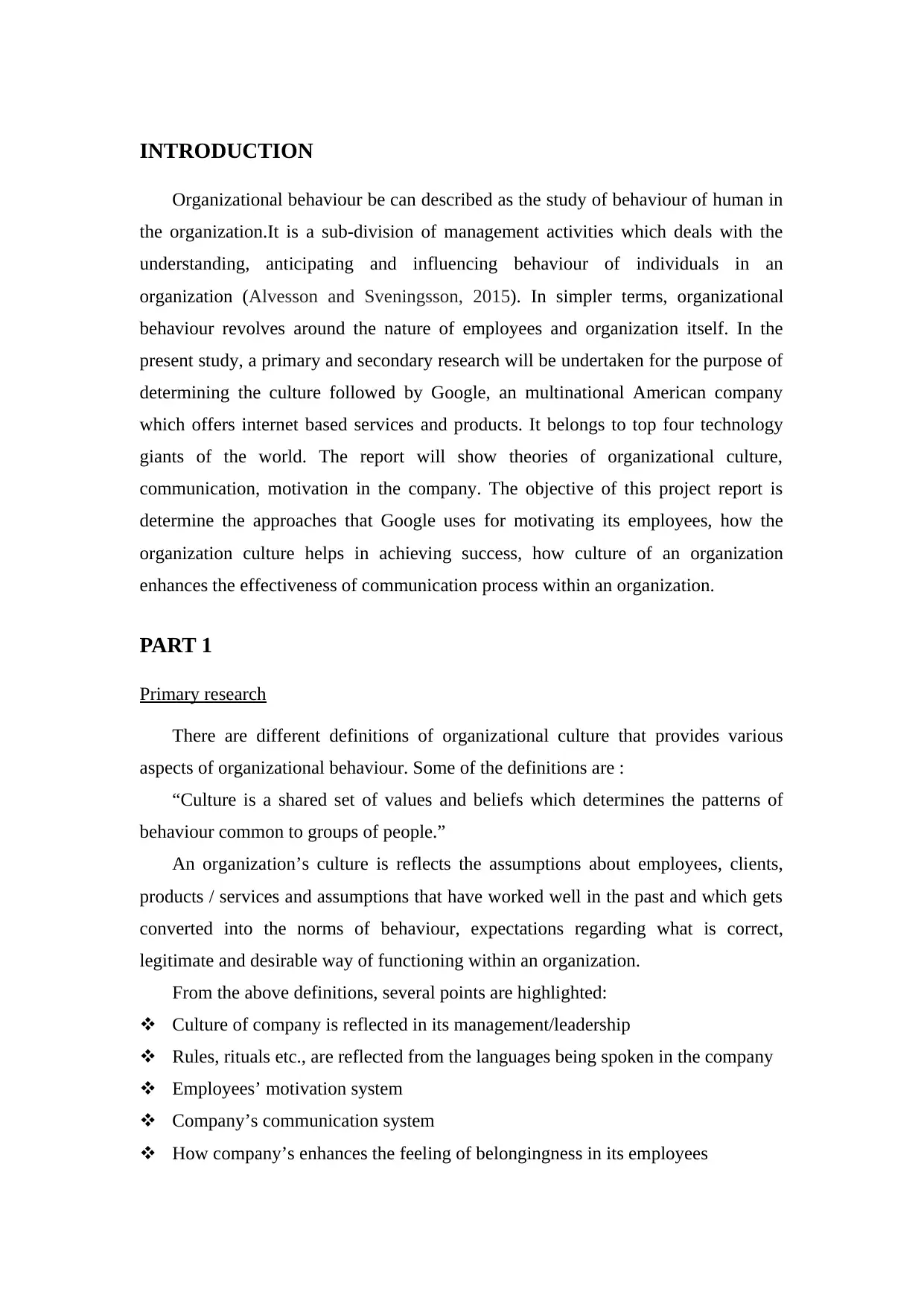
INTRODUCTION
Organizational behaviour be can described as the study of behaviour of human in
the organization.It is a sub-division of management activities which deals with the
understanding, anticipating and influencing behaviour of individuals in an
organization (Alvesson and Sveningsson, 2015). In simpler terms, organizational
behaviour revolves around the nature of employees and organization itself. In the
present study, a primary and secondary research will be undertaken for the purpose of
determining the culture followed by Google, an multinational American company
which offers internet based services and products. It belongs to top four technology
giants of the world. The report will show theories of organizational culture,
communication, motivation in the company. The objective of this project report is
determine the approaches that Google uses for motivating its employees, how the
organization culture helps in achieving success, how culture of an organization
enhances the effectiveness of communication process within an organization.
PART 1
Primary research
There are different definitions of organizational culture that provides various
aspects of organizational behaviour. Some of the definitions are :
“Culture is a shared set of values and beliefs which determines the patterns of
behaviour common to groups of people.”
An organization’s culture is reflects the assumptions about employees, clients,
products / services and assumptions that have worked well in the past and which gets
converted into the norms of behaviour, expectations regarding what is correct,
legitimate and desirable way of functioning within an organization.
From the above definitions, several points are highlighted:
Culture of company is reflected in its management/leadership
Rules, rituals etc., are reflected from the languages being spoken in the company
Employees’ motivation system
Company’s communication system
How company’s enhances the feeling of belongingness in its employees
Organizational behaviour be can described as the study of behaviour of human in
the organization.It is a sub-division of management activities which deals with the
understanding, anticipating and influencing behaviour of individuals in an
organization (Alvesson and Sveningsson, 2015). In simpler terms, organizational
behaviour revolves around the nature of employees and organization itself. In the
present study, a primary and secondary research will be undertaken for the purpose of
determining the culture followed by Google, an multinational American company
which offers internet based services and products. It belongs to top four technology
giants of the world. The report will show theories of organizational culture,
communication, motivation in the company. The objective of this project report is
determine the approaches that Google uses for motivating its employees, how the
organization culture helps in achieving success, how culture of an organization
enhances the effectiveness of communication process within an organization.
PART 1
Primary research
There are different definitions of organizational culture that provides various
aspects of organizational behaviour. Some of the definitions are :
“Culture is a shared set of values and beliefs which determines the patterns of
behaviour common to groups of people.”
An organization’s culture is reflects the assumptions about employees, clients,
products / services and assumptions that have worked well in the past and which gets
converted into the norms of behaviour, expectations regarding what is correct,
legitimate and desirable way of functioning within an organization.
From the above definitions, several points are highlighted:
Culture of company is reflected in its management/leadership
Rules, rituals etc., are reflected from the languages being spoken in the company
Employees’ motivation system
Company’s communication system
How company’s enhances the feeling of belongingness in its employees
⊘ This is a preview!⊘
Do you want full access?
Subscribe today to unlock all pages.

Trusted by 1+ million students worldwide
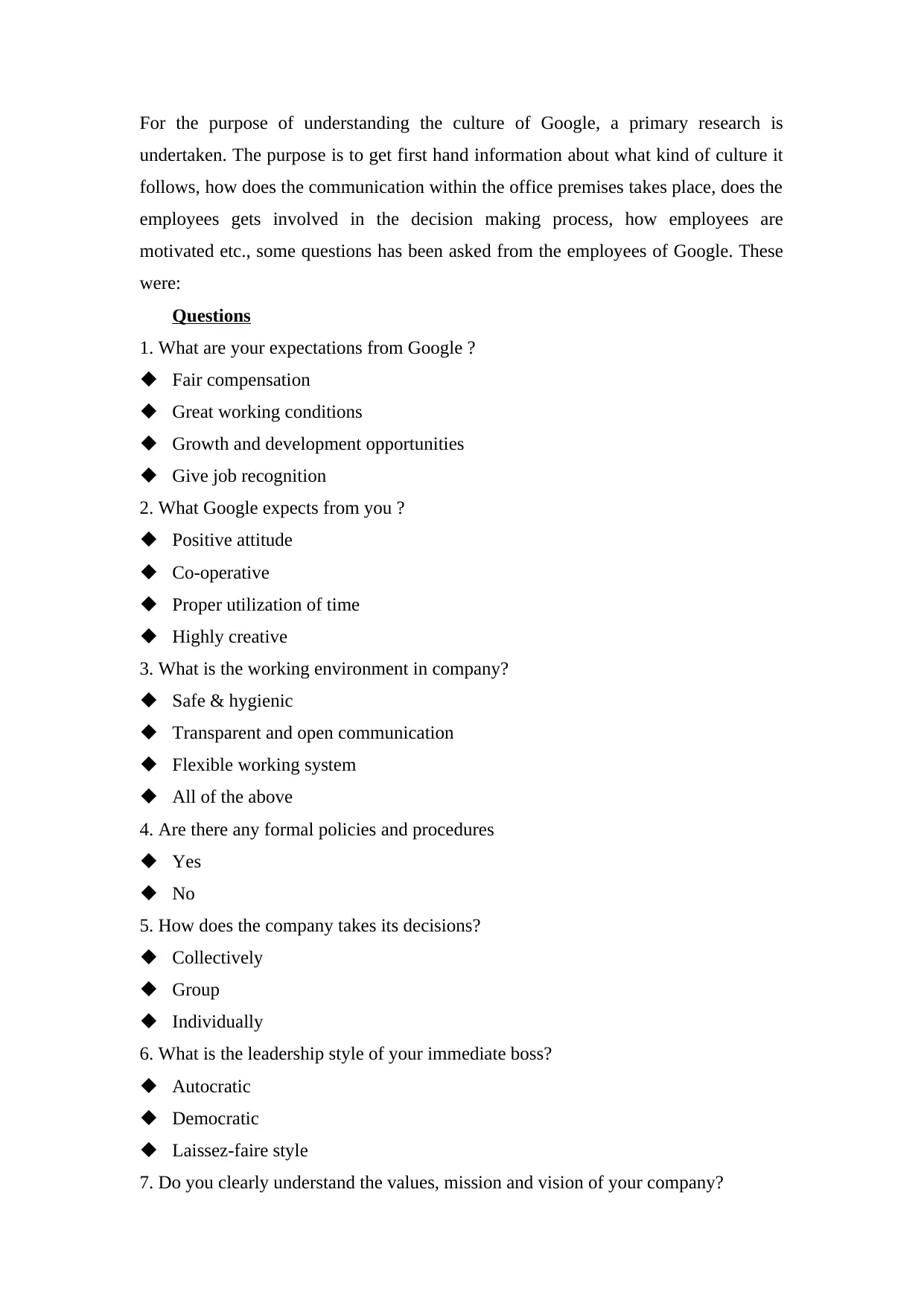
For the purpose of understanding the culture of Google, a primary research is
undertaken. The purpose is to get first hand information about what kind of culture it
follows, how does the communication within the office premises takes place, does the
employees gets involved in the decision making process, how employees are
motivated etc., some questions has been asked from the employees of Google. These
were:
Questions
1. What are your expectations from Google ?
Fair compensation
Great working conditions
Growth and development opportunities
Give job recognition
2. What Google expects from you ?
Positive attitude
Co-operative
Proper utilization of time
Highly creative
3. What is the working environment in company?
Safe & hygienic
Transparent and open communication
Flexible working system
All of the above
4. Are there any formal policies and procedures
Yes
No
5. How does the company takes its decisions?
Collectively
Group
Individually
6. What is the leadership style of your immediate boss?
Autocratic
Democratic
Laissez-faire style
7. Do you clearly understand the values, mission and vision of your company?
undertaken. The purpose is to get first hand information about what kind of culture it
follows, how does the communication within the office premises takes place, does the
employees gets involved in the decision making process, how employees are
motivated etc., some questions has been asked from the employees of Google. These
were:
Questions
1. What are your expectations from Google ?
Fair compensation
Great working conditions
Growth and development opportunities
Give job recognition
2. What Google expects from you ?
Positive attitude
Co-operative
Proper utilization of time
Highly creative
3. What is the working environment in company?
Safe & hygienic
Transparent and open communication
Flexible working system
All of the above
4. Are there any formal policies and procedures
Yes
No
5. How does the company takes its decisions?
Collectively
Group
Individually
6. What is the leadership style of your immediate boss?
Autocratic
Democratic
Laissez-faire style
7. Do you clearly understand the values, mission and vision of your company?
Paraphrase This Document
Need a fresh take? Get an instant paraphrase of this document with our AI Paraphraser
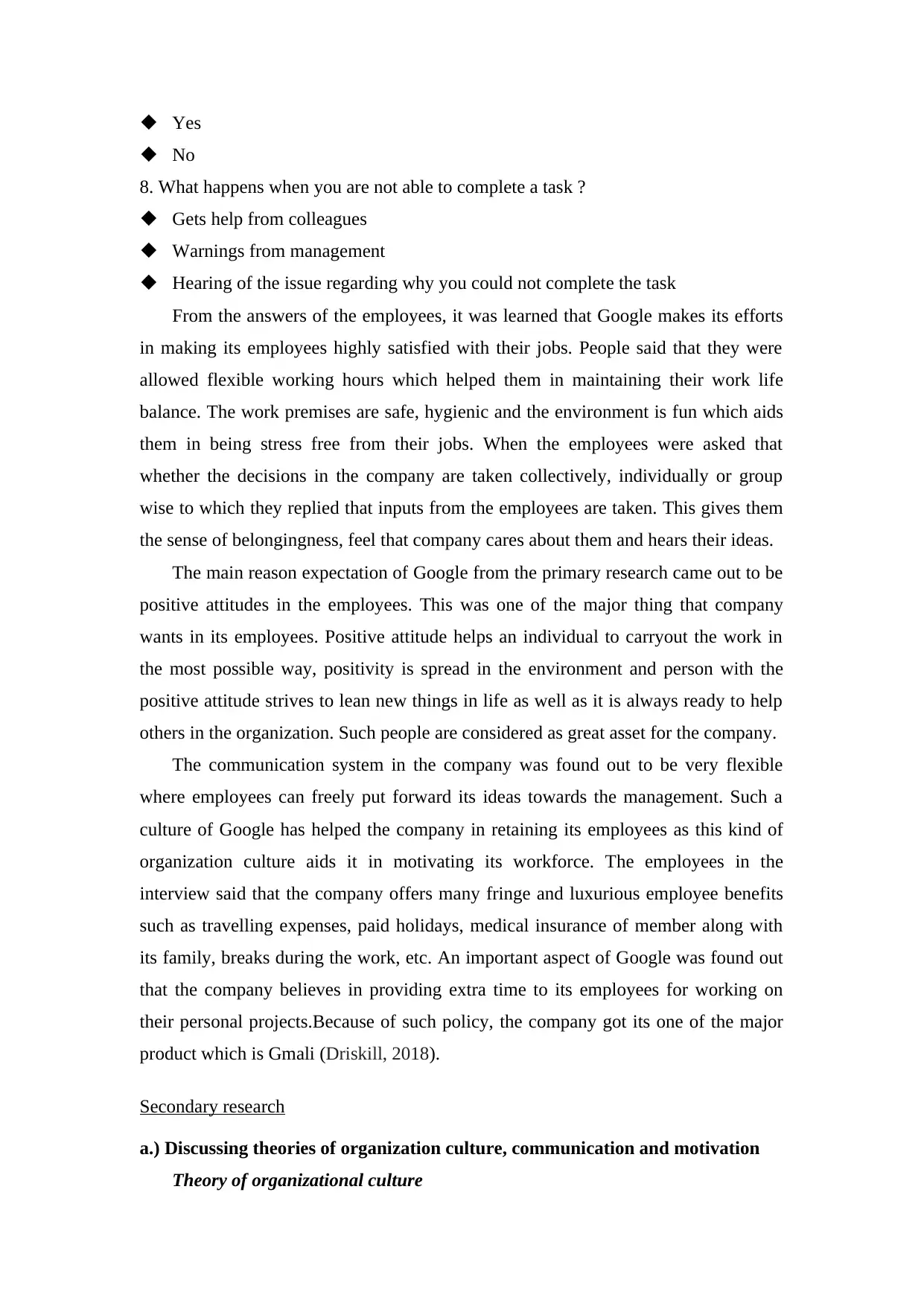
Yes
No
8. What happens when you are not able to complete a task ?
Gets help from colleagues
Warnings from management
Hearing of the issue regarding why you could not complete the task
From the answers of the employees, it was learned that Google makes its efforts
in making its employees highly satisfied with their jobs. People said that they were
allowed flexible working hours which helped them in maintaining their work life
balance. The work premises are safe, hygienic and the environment is fun which aids
them in being stress free from their jobs. When the employees were asked that
whether the decisions in the company are taken collectively, individually or group
wise to which they replied that inputs from the employees are taken. This gives them
the sense of belongingness, feel that company cares about them and hears their ideas.
The main reason expectation of Google from the primary research came out to be
positive attitudes in the employees. This was one of the major thing that company
wants in its employees. Positive attitude helps an individual to carryout the work in
the most possible way, positivity is spread in the environment and person with the
positive attitude strives to lean new things in life as well as it is always ready to help
others in the organization. Such people are considered as great asset for the company.
The communication system in the company was found out to be very flexible
where employees can freely put forward its ideas towards the management. Such a
culture of Google has helped the company in retaining its employees as this kind of
organization culture aids it in motivating its workforce. The employees in the
interview said that the company offers many fringe and luxurious employee benefits
such as travelling expenses, paid holidays, medical insurance of member along with
its family, breaks during the work, etc. An important aspect of Google was found out
that the company believes in providing extra time to its employees for working on
their personal projects.Because of such policy, the company got its one of the major
product which is Gmali (Driskill, 2018).
Secondary research
a.) Discussing theories of organization culture, communication and motivation
Theory of organizational culture
No
8. What happens when you are not able to complete a task ?
Gets help from colleagues
Warnings from management
Hearing of the issue regarding why you could not complete the task
From the answers of the employees, it was learned that Google makes its efforts
in making its employees highly satisfied with their jobs. People said that they were
allowed flexible working hours which helped them in maintaining their work life
balance. The work premises are safe, hygienic and the environment is fun which aids
them in being stress free from their jobs. When the employees were asked that
whether the decisions in the company are taken collectively, individually or group
wise to which they replied that inputs from the employees are taken. This gives them
the sense of belongingness, feel that company cares about them and hears their ideas.
The main reason expectation of Google from the primary research came out to be
positive attitudes in the employees. This was one of the major thing that company
wants in its employees. Positive attitude helps an individual to carryout the work in
the most possible way, positivity is spread in the environment and person with the
positive attitude strives to lean new things in life as well as it is always ready to help
others in the organization. Such people are considered as great asset for the company.
The communication system in the company was found out to be very flexible
where employees can freely put forward its ideas towards the management. Such a
culture of Google has helped the company in retaining its employees as this kind of
organization culture aids it in motivating its workforce. The employees in the
interview said that the company offers many fringe and luxurious employee benefits
such as travelling expenses, paid holidays, medical insurance of member along with
its family, breaks during the work, etc. An important aspect of Google was found out
that the company believes in providing extra time to its employees for working on
their personal projects.Because of such policy, the company got its one of the major
product which is Gmali (Driskill, 2018).
Secondary research
a.) Discussing theories of organization culture, communication and motivation
Theory of organizational culture
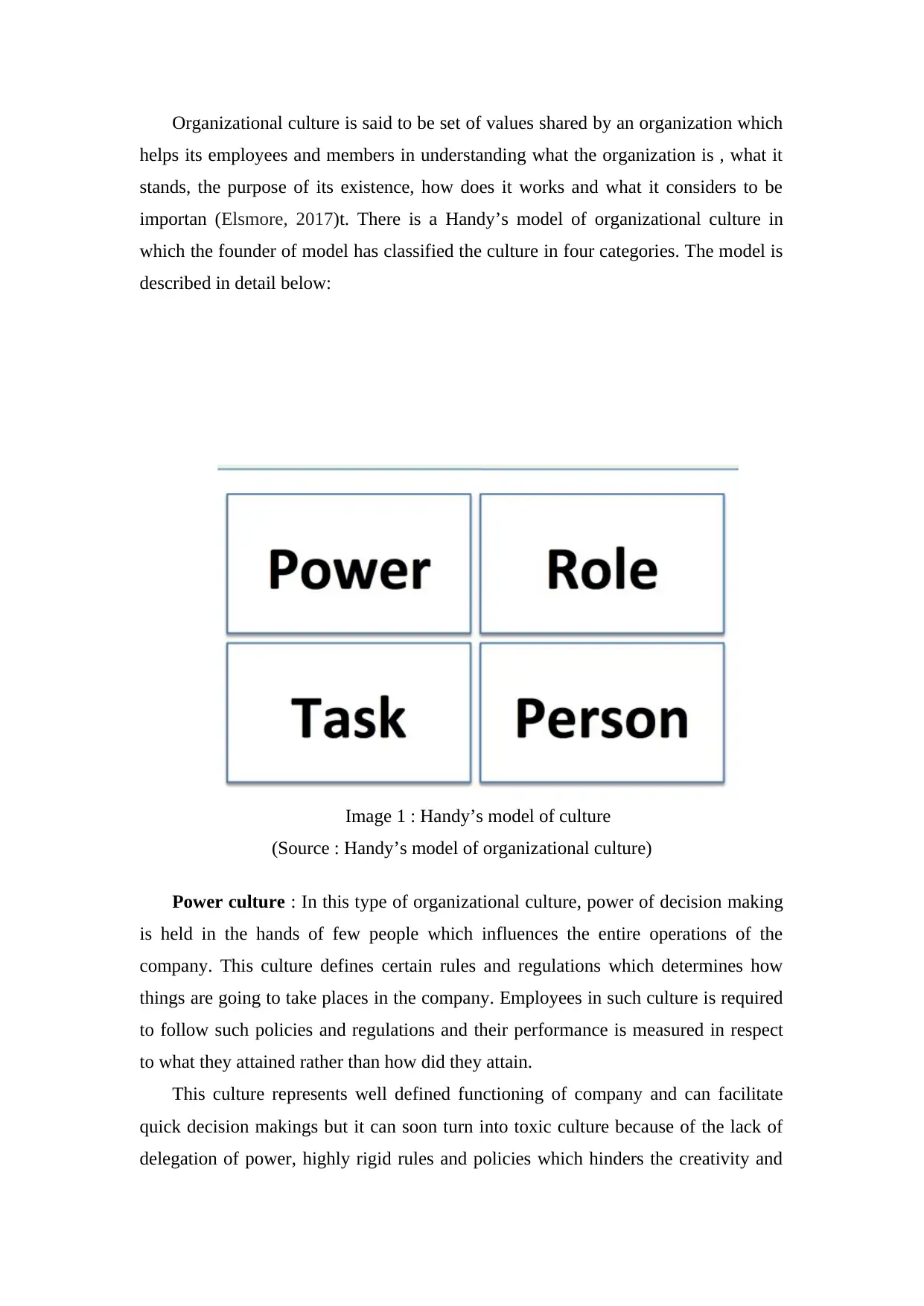
Organizational culture is said to be set of values shared by an organization which
helps its employees and members in understanding what the organization is , what it
stands, the purpose of its existence, how does it works and what it considers to be
importan (Elsmore, 2017)t. There is a Handy’s model of organizational culture in
which the founder of model has classified the culture in four categories. The model is
described in detail below:
Image 1 : Handy’s model of culture
(Source : Handy’s model of organizational culture)
Power culture : In this type of organizational culture, power of decision making
is held in the hands of few people which influences the entire operations of the
company. This culture defines certain rules and regulations which determines how
things are going to take places in the company. Employees in such culture is required
to follow such policies and regulations and their performance is measured in respect
to what they attained rather than how did they attain.
This culture represents well defined functioning of company and can facilitate
quick decision makings but it can soon turn into toxic culture because of the lack of
delegation of power, highly rigid rules and policies which hinders the creativity and
helps its employees and members in understanding what the organization is , what it
stands, the purpose of its existence, how does it works and what it considers to be
importan (Elsmore, 2017)t. There is a Handy’s model of organizational culture in
which the founder of model has classified the culture in four categories. The model is
described in detail below:
Image 1 : Handy’s model of culture
(Source : Handy’s model of organizational culture)
Power culture : In this type of organizational culture, power of decision making
is held in the hands of few people which influences the entire operations of the
company. This culture defines certain rules and regulations which determines how
things are going to take places in the company. Employees in such culture is required
to follow such policies and regulations and their performance is measured in respect
to what they attained rather than how did they attain.
This culture represents well defined functioning of company and can facilitate
quick decision makings but it can soon turn into toxic culture because of the lack of
delegation of power, highly rigid rules and policies which hinders the creativity and
⊘ This is a preview!⊘
Do you want full access?
Subscribe today to unlock all pages.

Trusted by 1+ million students worldwide
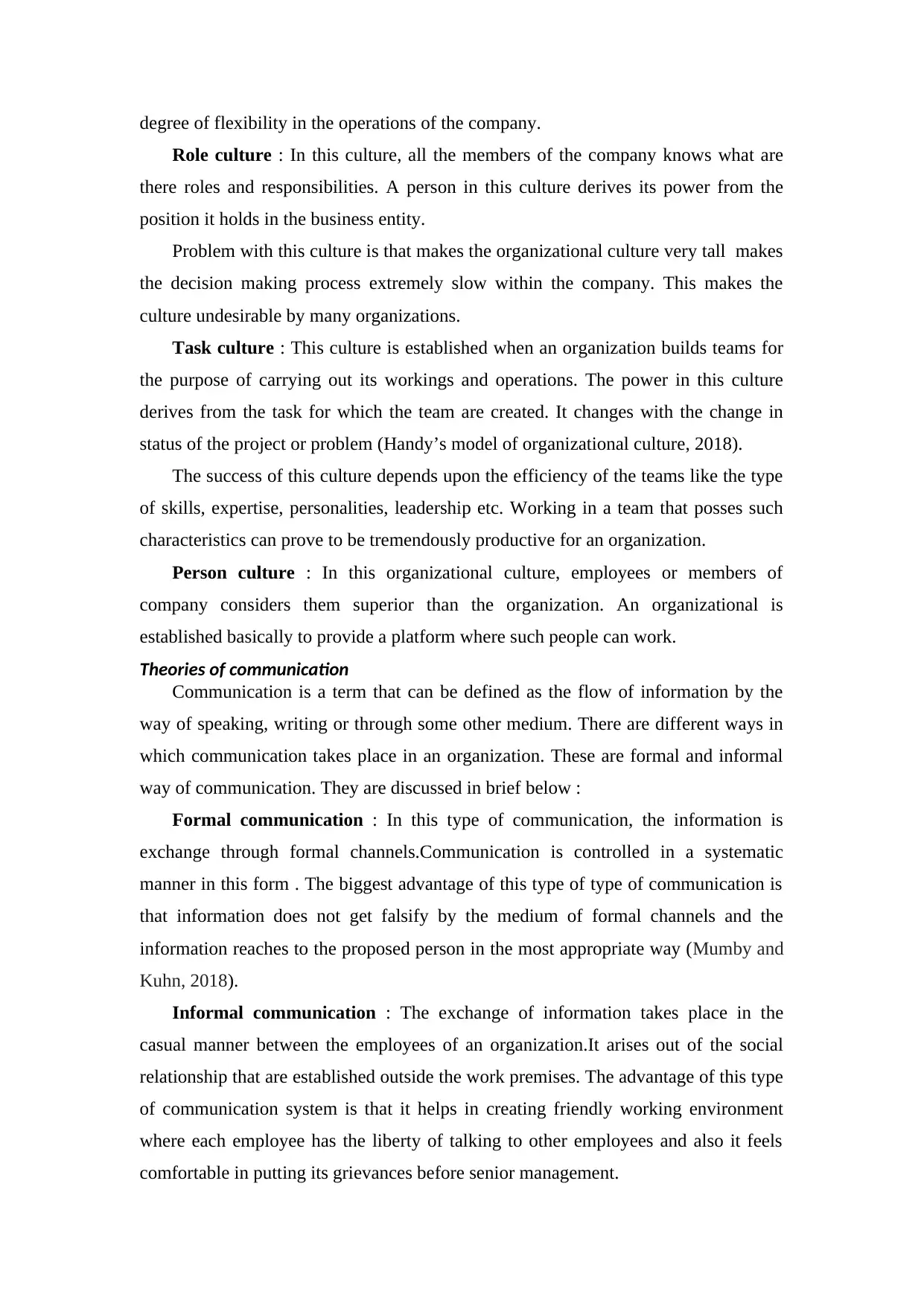
degree of flexibility in the operations of the company.
Role culture : In this culture, all the members of the company knows what are
there roles and responsibilities. A person in this culture derives its power from the
position it holds in the business entity.
Problem with this culture is that makes the organizational culture very tall makes
the decision making process extremely slow within the company. This makes the
culture undesirable by many organizations.
Task culture : This culture is established when an organization builds teams for
the purpose of carrying out its workings and operations. The power in this culture
derives from the task for which the team are created. It changes with the change in
status of the project or problem (Handy’s model of organizational culture, 2018).
The success of this culture depends upon the efficiency of the teams like the type
of skills, expertise, personalities, leadership etc. Working in a team that posses such
characteristics can prove to be tremendously productive for an organization.
Person culture : In this organizational culture, employees or members of
company considers them superior than the organization. An organizational is
established basically to provide a platform where such people can work.
Theories of communication
Communication is a term that can be defined as the flow of information by the
way of speaking, writing or through some other medium. There are different ways in
which communication takes place in an organization. These are formal and informal
way of communication. They are discussed in brief below :
Formal communication : In this type of communication, the information is
exchange through formal channels.Communication is controlled in a systematic
manner in this form . The biggest advantage of this type of type of communication is
that information does not get falsify by the medium of formal channels and the
information reaches to the proposed person in the most appropriate way (Mumby and
Kuhn, 2018).
Informal communication : The exchange of information takes place in the
casual manner between the employees of an organization.It arises out of the social
relationship that are established outside the work premises. The advantage of this type
of communication system is that it helps in creating friendly working environment
where each employee has the liberty of talking to other employees and also it feels
comfortable in putting its grievances before senior management.
Role culture : In this culture, all the members of the company knows what are
there roles and responsibilities. A person in this culture derives its power from the
position it holds in the business entity.
Problem with this culture is that makes the organizational culture very tall makes
the decision making process extremely slow within the company. This makes the
culture undesirable by many organizations.
Task culture : This culture is established when an organization builds teams for
the purpose of carrying out its workings and operations. The power in this culture
derives from the task for which the team are created. It changes with the change in
status of the project or problem (Handy’s model of organizational culture, 2018).
The success of this culture depends upon the efficiency of the teams like the type
of skills, expertise, personalities, leadership etc. Working in a team that posses such
characteristics can prove to be tremendously productive for an organization.
Person culture : In this organizational culture, employees or members of
company considers them superior than the organization. An organizational is
established basically to provide a platform where such people can work.
Theories of communication
Communication is a term that can be defined as the flow of information by the
way of speaking, writing or through some other medium. There are different ways in
which communication takes place in an organization. These are formal and informal
way of communication. They are discussed in brief below :
Formal communication : In this type of communication, the information is
exchange through formal channels.Communication is controlled in a systematic
manner in this form . The biggest advantage of this type of type of communication is
that information does not get falsify by the medium of formal channels and the
information reaches to the proposed person in the most appropriate way (Mumby and
Kuhn, 2018).
Informal communication : The exchange of information takes place in the
casual manner between the employees of an organization.It arises out of the social
relationship that are established outside the work premises. The advantage of this type
of communication system is that it helps in creating friendly working environment
where each employee has the liberty of talking to other employees and also it feels
comfortable in putting its grievances before senior management.
Paraphrase This Document
Need a fresh take? Get an instant paraphrase of this document with our AI Paraphraser
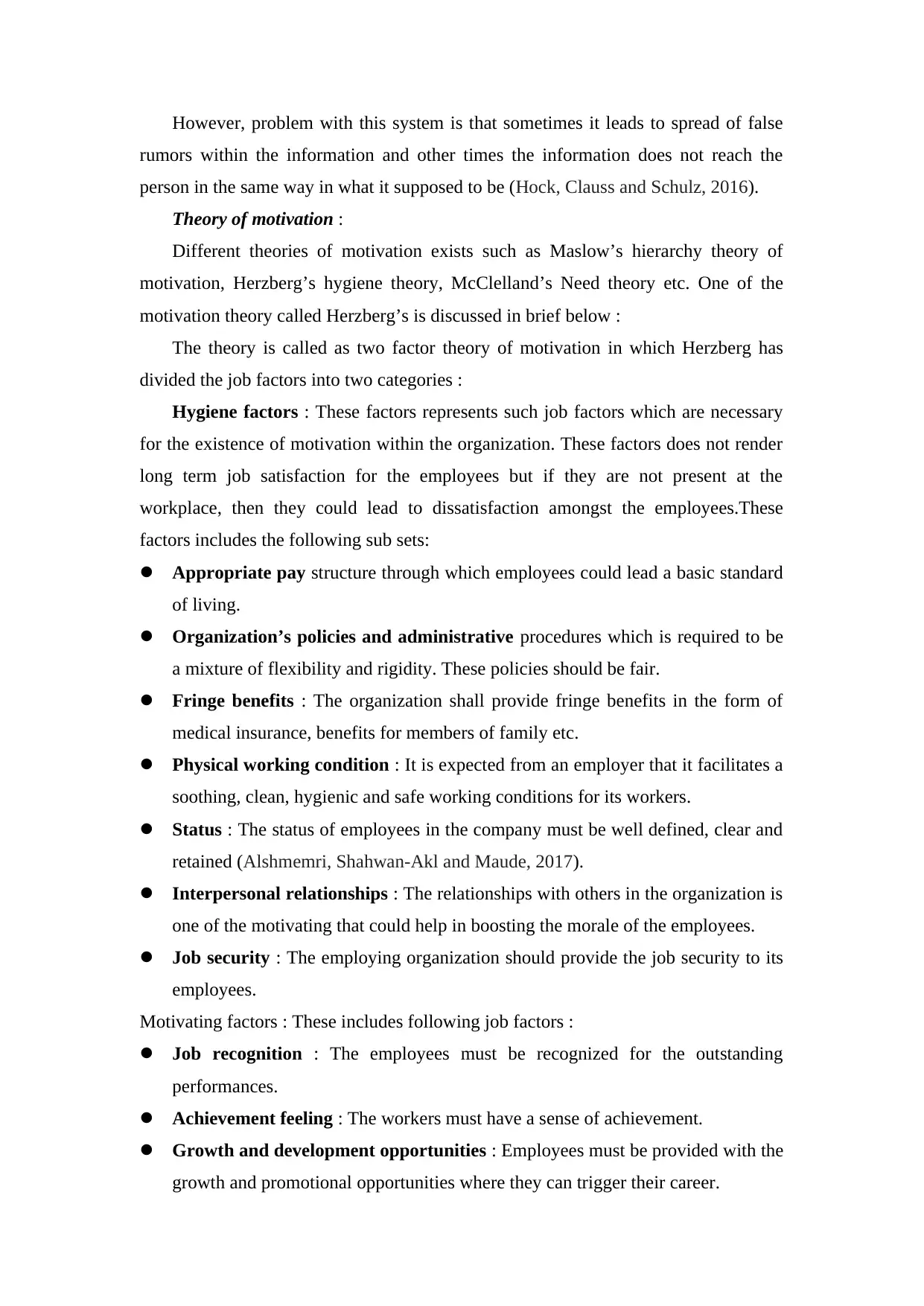
However, problem with this system is that sometimes it leads to spread of false
rumors within the information and other times the information does not reach the
person in the same way in what it supposed to be (Hock, Clauss and Schulz, 2016).
Theory of motivation :
Different theories of motivation exists such as Maslow’s hierarchy theory of
motivation, Herzberg’s hygiene theory, McClelland’s Need theory etc. One of the
motivation theory called Herzberg’s is discussed in brief below :
The theory is called as two factor theory of motivation in which Herzberg has
divided the job factors into two categories :
Hygiene factors : These factors represents such job factors which are necessary
for the existence of motivation within the organization. These factors does not render
long term job satisfaction for the employees but if they are not present at the
workplace, then they could lead to dissatisfaction amongst the employees.These
factors includes the following sub sets:
Appropriate pay structure through which employees could lead a basic standard
of living.
Organization’s policies and administrative procedures which is required to be
a mixture of flexibility and rigidity. These policies should be fair.
Fringe benefits : The organization shall provide fringe benefits in the form of
medical insurance, benefits for members of family etc.
Physical working condition : It is expected from an employer that it facilitates a
soothing, clean, hygienic and safe working conditions for its workers.
Status : The status of employees in the company must be well defined, clear and
retained (Alshmemri, Shahwan-Akl and Maude, 2017).
Interpersonal relationships : The relationships with others in the organization is
one of the motivating that could help in boosting the morale of the employees.
Job security : The employing organization should provide the job security to its
employees.
Motivating factors : These includes following job factors :
Job recognition : The employees must be recognized for the outstanding
performances.
Achievement feeling : The workers must have a sense of achievement.
Growth and development opportunities : Employees must be provided with the
growth and promotional opportunities where they can trigger their career.
rumors within the information and other times the information does not reach the
person in the same way in what it supposed to be (Hock, Clauss and Schulz, 2016).
Theory of motivation :
Different theories of motivation exists such as Maslow’s hierarchy theory of
motivation, Herzberg’s hygiene theory, McClelland’s Need theory etc. One of the
motivation theory called Herzberg’s is discussed in brief below :
The theory is called as two factor theory of motivation in which Herzberg has
divided the job factors into two categories :
Hygiene factors : These factors represents such job factors which are necessary
for the existence of motivation within the organization. These factors does not render
long term job satisfaction for the employees but if they are not present at the
workplace, then they could lead to dissatisfaction amongst the employees.These
factors includes the following sub sets:
Appropriate pay structure through which employees could lead a basic standard
of living.
Organization’s policies and administrative procedures which is required to be
a mixture of flexibility and rigidity. These policies should be fair.
Fringe benefits : The organization shall provide fringe benefits in the form of
medical insurance, benefits for members of family etc.
Physical working condition : It is expected from an employer that it facilitates a
soothing, clean, hygienic and safe working conditions for its workers.
Status : The status of employees in the company must be well defined, clear and
retained (Alshmemri, Shahwan-Akl and Maude, 2017).
Interpersonal relationships : The relationships with others in the organization is
one of the motivating that could help in boosting the morale of the employees.
Job security : The employing organization should provide the job security to its
employees.
Motivating factors : These includes following job factors :
Job recognition : The employees must be recognized for the outstanding
performances.
Achievement feeling : The workers must have a sense of achievement.
Growth and development opportunities : Employees must be provided with the
growth and promotional opportunities where they can trigger their career.
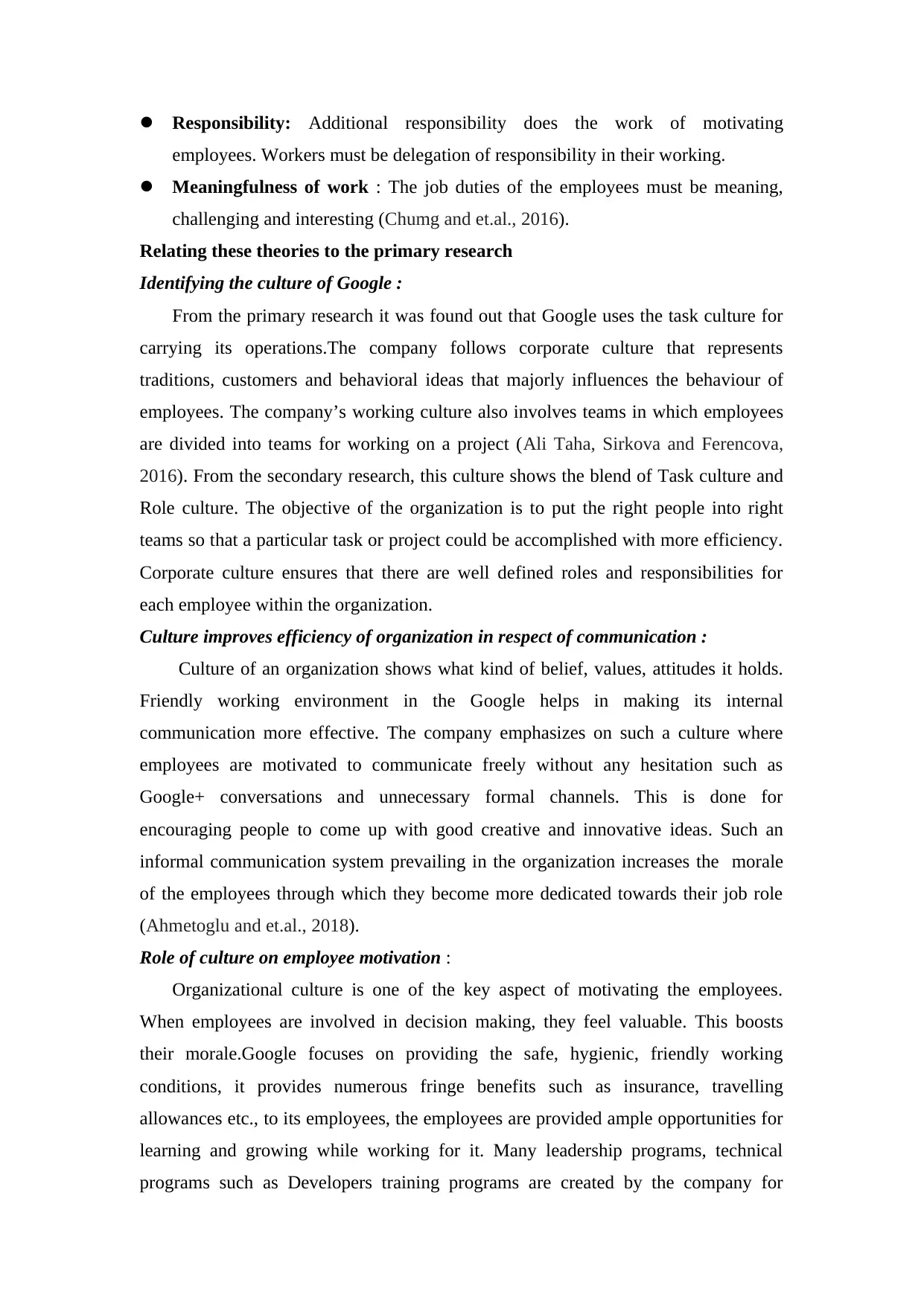
Responsibility: Additional responsibility does the work of motivating
employees. Workers must be delegation of responsibility in their working.
Meaningfulness of work : The job duties of the employees must be meaning,
challenging and interesting (Chumg and et.al., 2016).
Relating these theories to the primary research
Identifying the culture of Google :
From the primary research it was found out that Google uses the task culture for
carrying its operations.The company follows corporate culture that represents
traditions, customers and behavioral ideas that majorly influences the behaviour of
employees. The company’s working culture also involves teams in which employees
are divided into teams for working on a project (Ali Taha, Sirkova and Ferencova,
2016). From the secondary research, this culture shows the blend of Task culture and
Role culture. The objective of the organization is to put the right people into right
teams so that a particular task or project could be accomplished with more efficiency.
Corporate culture ensures that there are well defined roles and responsibilities for
each employee within the organization.
Culture improves efficiency of organization in respect of communication :
Culture of an organization shows what kind of belief, values, attitudes it holds.
Friendly working environment in the Google helps in making its internal
communication more effective. The company emphasizes on such a culture where
employees are motivated to communicate freely without any hesitation such as
Google+ conversations and unnecessary formal channels. This is done for
encouraging people to come up with good creative and innovative ideas. Such an
informal communication system prevailing in the organization increases the morale
of the employees through which they become more dedicated towards their job role
(Ahmetoglu and et.al., 2018).
Role of culture on employee motivation :
Organizational culture is one of the key aspect of motivating the employees.
When employees are involved in decision making, they feel valuable. This boosts
their morale.Google focuses on providing the safe, hygienic, friendly working
conditions, it provides numerous fringe benefits such as insurance, travelling
allowances etc., to its employees, the employees are provided ample opportunities for
learning and growing while working for it. Many leadership programs, technical
programs such as Developers training programs are created by the company for
employees. Workers must be delegation of responsibility in their working.
Meaningfulness of work : The job duties of the employees must be meaning,
challenging and interesting (Chumg and et.al., 2016).
Relating these theories to the primary research
Identifying the culture of Google :
From the primary research it was found out that Google uses the task culture for
carrying its operations.The company follows corporate culture that represents
traditions, customers and behavioral ideas that majorly influences the behaviour of
employees. The company’s working culture also involves teams in which employees
are divided into teams for working on a project (Ali Taha, Sirkova and Ferencova,
2016). From the secondary research, this culture shows the blend of Task culture and
Role culture. The objective of the organization is to put the right people into right
teams so that a particular task or project could be accomplished with more efficiency.
Corporate culture ensures that there are well defined roles and responsibilities for
each employee within the organization.
Culture improves efficiency of organization in respect of communication :
Culture of an organization shows what kind of belief, values, attitudes it holds.
Friendly working environment in the Google helps in making its internal
communication more effective. The company emphasizes on such a culture where
employees are motivated to communicate freely without any hesitation such as
Google+ conversations and unnecessary formal channels. This is done for
encouraging people to come up with good creative and innovative ideas. Such an
informal communication system prevailing in the organization increases the morale
of the employees through which they become more dedicated towards their job role
(Ahmetoglu and et.al., 2018).
Role of culture on employee motivation :
Organizational culture is one of the key aspect of motivating the employees.
When employees are involved in decision making, they feel valuable. This boosts
their morale.Google focuses on providing the safe, hygienic, friendly working
conditions, it provides numerous fringe benefits such as insurance, travelling
allowances etc., to its employees, the employees are provided ample opportunities for
learning and growing while working for it. Many leadership programs, technical
programs such as Developers training programs are created by the company for
⊘ This is a preview!⊘
Do you want full access?
Subscribe today to unlock all pages.

Trusted by 1+ million students worldwide
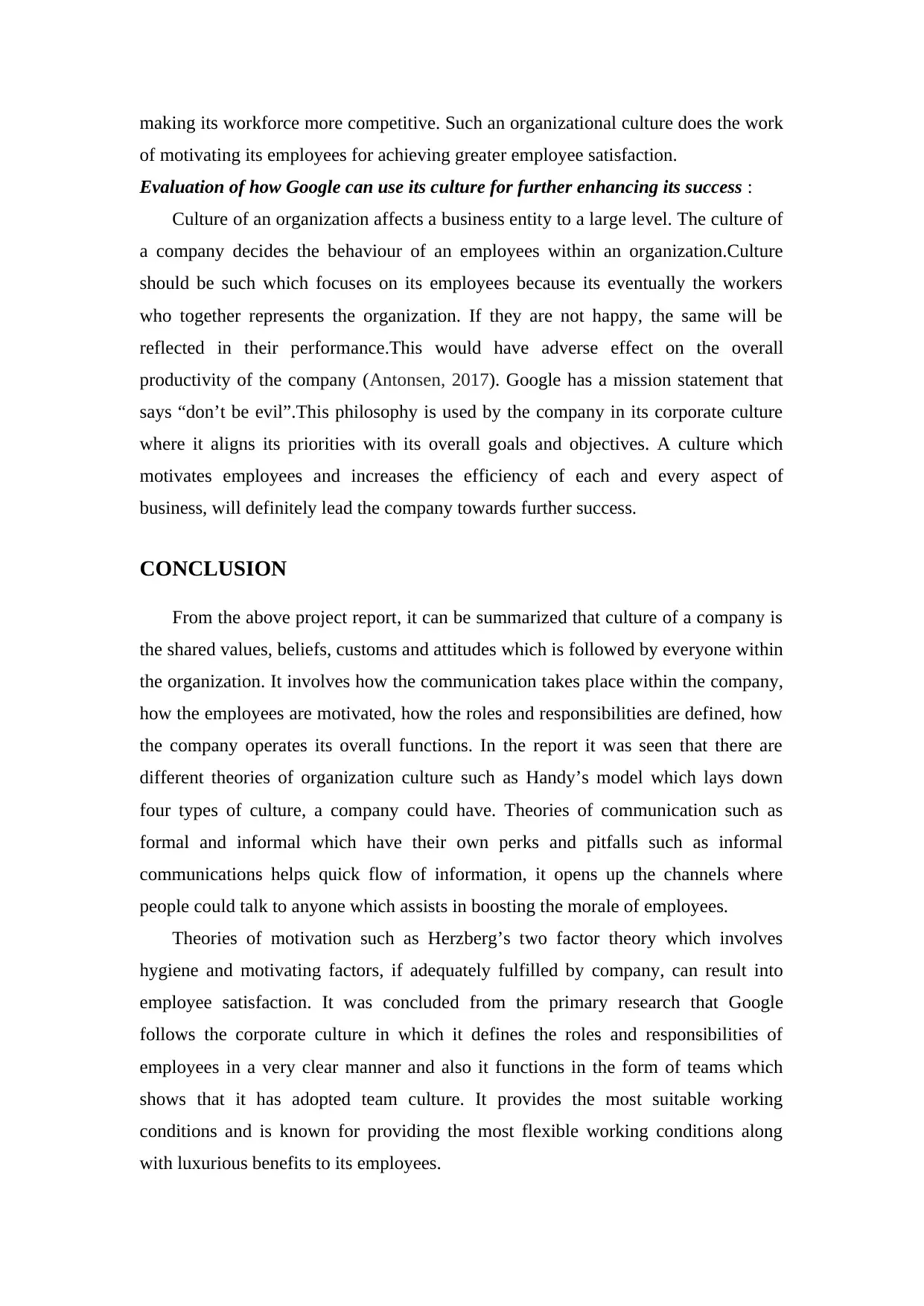
making its workforce more competitive. Such an organizational culture does the work
of motivating its employees for achieving greater employee satisfaction.
Evaluation of how Google can use its culture for further enhancing its success :
Culture of an organization affects a business entity to a large level. The culture of
a company decides the behaviour of an employees within an organization.Culture
should be such which focuses on its employees because its eventually the workers
who together represents the organization. If they are not happy, the same will be
reflected in their performance.This would have adverse effect on the overall
productivity of the company (Antonsen, 2017). Google has a mission statement that
says “don’t be evil”.This philosophy is used by the company in its corporate culture
where it aligns its priorities with its overall goals and objectives. A culture which
motivates employees and increases the efficiency of each and every aspect of
business, will definitely lead the company towards further success.
CONCLUSION
From the above project report, it can be summarized that culture of a company is
the shared values, beliefs, customs and attitudes which is followed by everyone within
the organization. It involves how the communication takes place within the company,
how the employees are motivated, how the roles and responsibilities are defined, how
the company operates its overall functions. In the report it was seen that there are
different theories of organization culture such as Handy’s model which lays down
four types of culture, a company could have. Theories of communication such as
formal and informal which have their own perks and pitfalls such as informal
communications helps quick flow of information, it opens up the channels where
people could talk to anyone which assists in boosting the morale of employees.
Theories of motivation such as Herzberg’s two factor theory which involves
hygiene and motivating factors, if adequately fulfilled by company, can result into
employee satisfaction. It was concluded from the primary research that Google
follows the corporate culture in which it defines the roles and responsibilities of
employees in a very clear manner and also it functions in the form of teams which
shows that it has adopted team culture. It provides the most suitable working
conditions and is known for providing the most flexible working conditions along
with luxurious benefits to its employees.
of motivating its employees for achieving greater employee satisfaction.
Evaluation of how Google can use its culture for further enhancing its success :
Culture of an organization affects a business entity to a large level. The culture of
a company decides the behaviour of an employees within an organization.Culture
should be such which focuses on its employees because its eventually the workers
who together represents the organization. If they are not happy, the same will be
reflected in their performance.This would have adverse effect on the overall
productivity of the company (Antonsen, 2017). Google has a mission statement that
says “don’t be evil”.This philosophy is used by the company in its corporate culture
where it aligns its priorities with its overall goals and objectives. A culture which
motivates employees and increases the efficiency of each and every aspect of
business, will definitely lead the company towards further success.
CONCLUSION
From the above project report, it can be summarized that culture of a company is
the shared values, beliefs, customs and attitudes which is followed by everyone within
the organization. It involves how the communication takes place within the company,
how the employees are motivated, how the roles and responsibilities are defined, how
the company operates its overall functions. In the report it was seen that there are
different theories of organization culture such as Handy’s model which lays down
four types of culture, a company could have. Theories of communication such as
formal and informal which have their own perks and pitfalls such as informal
communications helps quick flow of information, it opens up the channels where
people could talk to anyone which assists in boosting the morale of employees.
Theories of motivation such as Herzberg’s two factor theory which involves
hygiene and motivating factors, if adequately fulfilled by company, can result into
employee satisfaction. It was concluded from the primary research that Google
follows the corporate culture in which it defines the roles and responsibilities of
employees in a very clear manner and also it functions in the form of teams which
shows that it has adopted team culture. It provides the most suitable working
conditions and is known for providing the most flexible working conditions along
with luxurious benefits to its employees.
Paraphrase This Document
Need a fresh take? Get an instant paraphrase of this document with our AI Paraphraser

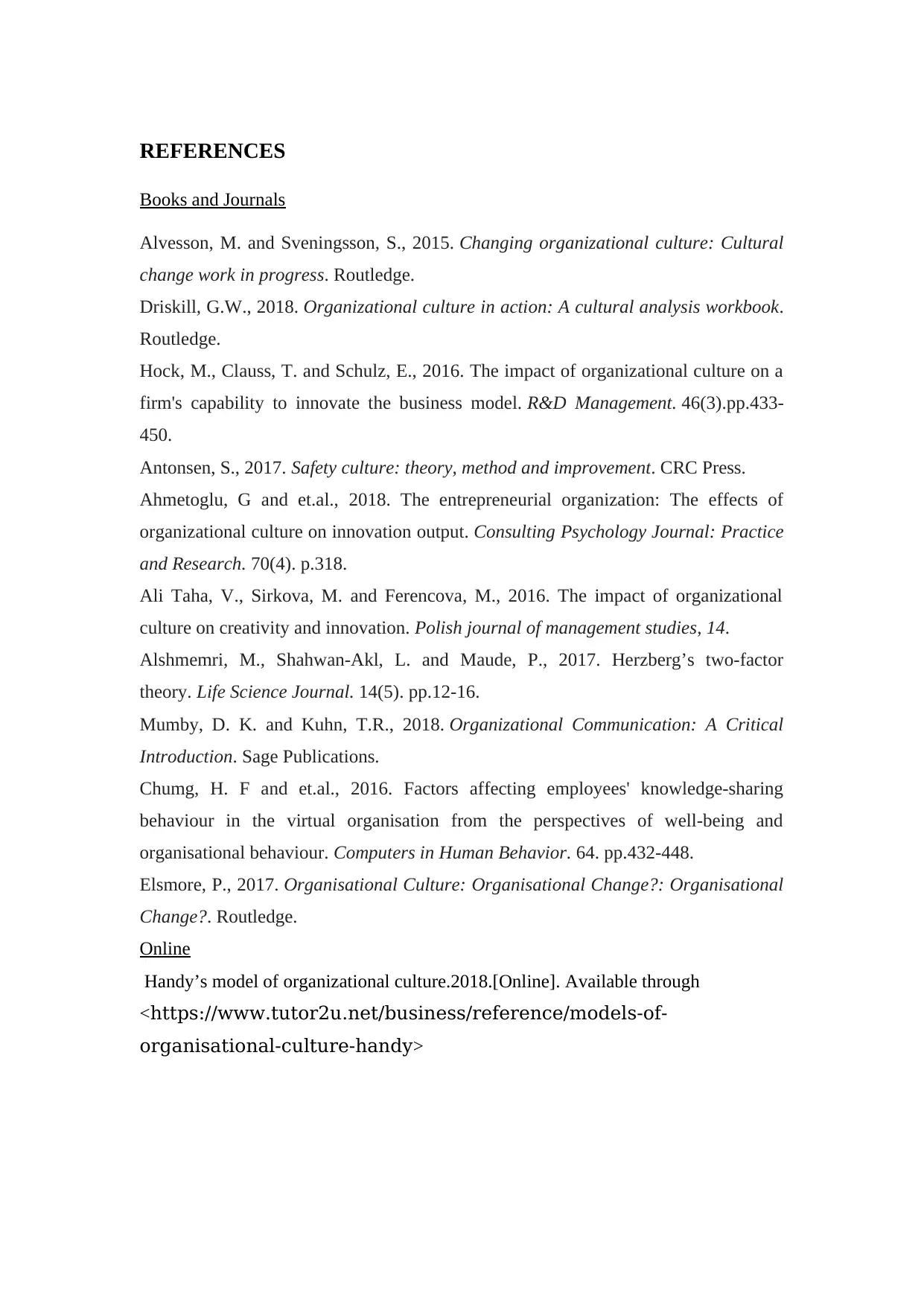
REFERENCES
Books and Journals
Alvesson, M. and Sveningsson, S., 2015. Changing organizational culture: Cultural
change work in progress. Routledge.
Driskill, G.W., 2018. Organizational culture in action: A cultural analysis workbook.
Routledge.
Hock, M., Clauss, T. and Schulz, E., 2016. The impact of organizational culture on a
firm's capability to innovate the business model. R&D Management. 46(3).pp.433-
450.
Antonsen, S., 2017. Safety culture: theory, method and improvement. CRC Press.
Ahmetoglu, G and et.al., 2018. The entrepreneurial organization: The effects of
organizational culture on innovation output. Consulting Psychology Journal: Practice
and Research. 70(4). p.318.
Ali Taha, V., Sirkova, M. and Ferencova, M., 2016. The impact of organizational
culture on creativity and innovation. Polish journal of management studies, 14.
Alshmemri, M., Shahwan-Akl, L. and Maude, P., 2017. Herzberg’s two-factor
theory. Life Science Journal. 14(5). pp.12-16.
Mumby, D. K. and Kuhn, T.R., 2018. Organizational Communication: A Critical
Introduction. Sage Publications.
Chumg, H. F and et.al., 2016. Factors affecting employees' knowledge-sharing
behaviour in the virtual organisation from the perspectives of well-being and
organisational behaviour. Computers in Human Behavior. 64. pp.432-448.
Elsmore, P., 2017. Organisational Culture: Organisational Change?: Organisational
Change?. Routledge.
Online
Handy’s model of organizational culture.2018.[Online]. Available through
<https://www.tutor2u.net/business/reference/models-of-
organisational-culture-handy>
Books and Journals
Alvesson, M. and Sveningsson, S., 2015. Changing organizational culture: Cultural
change work in progress. Routledge.
Driskill, G.W., 2018. Organizational culture in action: A cultural analysis workbook.
Routledge.
Hock, M., Clauss, T. and Schulz, E., 2016. The impact of organizational culture on a
firm's capability to innovate the business model. R&D Management. 46(3).pp.433-
450.
Antonsen, S., 2017. Safety culture: theory, method and improvement. CRC Press.
Ahmetoglu, G and et.al., 2018. The entrepreneurial organization: The effects of
organizational culture on innovation output. Consulting Psychology Journal: Practice
and Research. 70(4). p.318.
Ali Taha, V., Sirkova, M. and Ferencova, M., 2016. The impact of organizational
culture on creativity and innovation. Polish journal of management studies, 14.
Alshmemri, M., Shahwan-Akl, L. and Maude, P., 2017. Herzberg’s two-factor
theory. Life Science Journal. 14(5). pp.12-16.
Mumby, D. K. and Kuhn, T.R., 2018. Organizational Communication: A Critical
Introduction. Sage Publications.
Chumg, H. F and et.al., 2016. Factors affecting employees' knowledge-sharing
behaviour in the virtual organisation from the perspectives of well-being and
organisational behaviour. Computers in Human Behavior. 64. pp.432-448.
Elsmore, P., 2017. Organisational Culture: Organisational Change?: Organisational
Change?. Routledge.
Online
Handy’s model of organizational culture.2018.[Online]. Available through
<https://www.tutor2u.net/business/reference/models-of-
organisational-culture-handy>
⊘ This is a preview!⊘
Do you want full access?
Subscribe today to unlock all pages.

Trusted by 1+ million students worldwide
1 out of 12
Related Documents
Your All-in-One AI-Powered Toolkit for Academic Success.
+13062052269
info@desklib.com
Available 24*7 on WhatsApp / Email
![[object Object]](/_next/static/media/star-bottom.7253800d.svg)
Unlock your academic potential
Copyright © 2020–2025 A2Z Services. All Rights Reserved. Developed and managed by ZUCOL.





